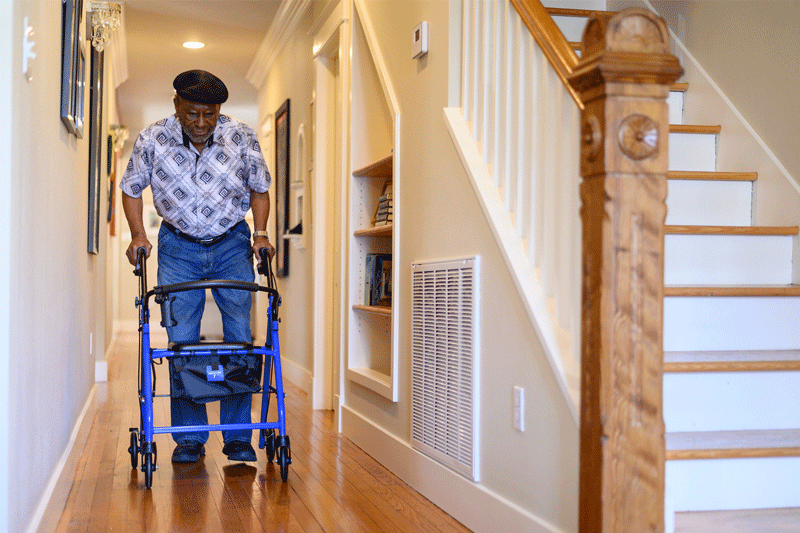How to Stay on Your Feet: 5 Proven Ways to Prevent Falls at Home
Falls are the leading cause of injury in older adults, but they’re not just “accidents.” Many are predictable—and preventable. The way your home is set up, how strong your legs are, and even the shoes you wear can all influence your risk of falling.
If you’ve ever tripped on a rug, felt unsteady getting out of bed, or hesitated at stairs, this guide is for you. Below are five practical, research-backed ways to reduce fall risk and stay confidently on your feet—starting right now.
1. Rearrange Your Living Space for Safety
Your home should work with you—not against you. Make it easier to move freely without hazards in the way.
Try This:
-
Remove throw rugs or secure them with non-slip pads
-
Keep pathways clear of clutter, cords, or furniture
-
Install grab bars in the bathroom near the toilet and shower
-
Add railings on both sides of staircases
-
Improve lighting in hallways and stairwells
Need a full home safety checklist? Check out the CDC’s Home Fall Prevention Guide.
2. Strengthen the Muscles That Keep You Upright
One of the top reasons for falls? Leg weakness. Aging naturally reduces muscle mass, especially in the hips, thighs, and calves. But targeted strength training can reverse this and boost your stability.
Focus On:
-
Sit-to-stand exercises
-
Wall squats or step-ups
-
Heel raises and toe taps
-
Resistance band workouts
A customized physical therapy program can zero in on the muscles that need the most help and ensure you’re moving safely.
3. Train Your Balance—It’s a Skill, Not a Given
Just like strength, balance can be trained. As we age, we lose some of our natural ability to stay upright—especially when distracted or moving in different directions.
At-Home Drills:
-
Stand on one foot while brushing your teeth
-
Walk heel-to-toe along a straight line
-
Shift your weight side to side while holding a counter
-
Try standing with your eyes closed for a few seconds (safely supported)
Physical therapists also use more advanced methods like dual-task training to help improve balance under real-life conditions.
4. Wear the Right Shoes (and Avoid the Wrong Ones)
Footwear plays a huge role in fall prevention. Avoid flip-flops, backless slippers, or shoes with slick soles.
Choose:
-
Supportive shoes with non-skid soles
-
Low-heeled sneakers with good tread
-
Shoes that fit snugly and securely
If you have foot pain, poor circulation, or neuropathy, you may benefit from a podiatric consult or orthotics. Don’t guess—get guidance.
5. Get a Fall Risk Assessment Before Something Happens
Don’t wait until you’ve already fallen. A physical therapist can assess your current balance, strength, and mobility to spot risks before they become problems.
At Synaptic Rehabilitation in Bridgewater, NJ, our fall prevention programs are designed for older adults who want to stay independent, mobile, and safe. We work with you to build a personalized plan that fits your lifestyle and goals.
Not sure if it’s time? Learn the early signs of imbalance you shouldn’t ignore.
Your Next Step Toward Staying on Your Feet
You don’t have to overhaul your life to prevent a fall. Small, smart changes—like moving a lamp cord or starting a simple strength routine—can add up to real protection.
If you’re feeling unsteady, it’s not just “normal aging.” It’s your body telling you it needs support.
Book a Balance Screening Today
We help older adults regain strength, retrain balance, and reduce fall risk through evidence-based therapy.
📍 Visit us in Bridgewater, NJ
📞 Call us: 908-801-6425
🌐 Request an appointment online
Steven Cheung, DPT
Steven is the founder and lead physical therapist at SYNAPTIC Rehabilitation. He earned a BS in Exercise Science Applied Kinesiology from Rutgers University in New Brunswick, NJ and his Doctorate degree from American International College in Springfield, MA. Steven specializes in movement disorders such as Parkinson’s disease and many other neurological disorders. Outside of practicing physical therapy Steven enjoys time with his wife, running, and staying active.

